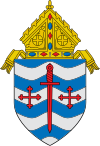University of St. Thomas (Minnesota)
 | |
Former names | College of St. Thomas (1885–1990) |
|---|---|
| Motto | All for the common good |
| Type | Private university |
| Established | 1885[1] |
Religious affiliation | Roman Catholic |
Academic affiliations | |
| Endowment | $540.6 million (2019)[2] |
| Budget | $374 million (2016)[3] |
| President | Julie Sullivan |
| Provost | Eddy M. Rojas |
Academic staff | 704[1] |
Administrative staff | 1,041 |
| Students | 9,878 (2017)[4] |
| Undergraduates | 6,199 (2017)[4] |
| Postgraduates | 3,679 (2017)[4] |
| Location | St. Paul–Minneapolis , Minnesota , United States 44°56′35″N 93°11′25″W / 44.94306°N 93.19028°WCoordinates: 44°56′35″N 93°11′25″W / 44.94306°N 93.19028°W |
| Campus | Urban: 78 acres (32 ha) |
| Colors | Purple & Gray |
| Athletics | NCAA Division I FCS – Summit League, Pioneer Football League |
| Nickname | Tommies |
| Sports | 11 men's and 11 women's varsity teams |
| Mascot | Tommie |
| Website | www |
| Academic rankings | |
|---|---|
| National | |
| Forbes[5] | 198 |
| THE/WSJ[6] | 303 |
| U.S. News & World Report[7] | 133 |
| Washington Monthly[8] | 171 |
The University of St. Thomas (St. Thomas) is a private, Catholic university in St. Paul and Minneapolis, Minnesota. Founded in 1885 as a Catholic seminary, it is named after Thomas Aquinas, the medieval Catholic theologian and philosopher who is the patron saint of students. St. Thomas currently[when?] enrolls nearly 10,000 students, making it Minnesota's largest private, nonprofit university.
History[]
Founded in 1885 by John Ireland, archbishop of Saint Paul and Minneapolis, St. Thomas began as an all-male, Catholic seminary.[9] In 1894, the liberal arts program became an independent college through a gift from local railroad tycoon James J. Hill, who provided funds to establish the Saint Paul Seminary School of Divinity apart from the college.[9] In 1903, the College of St. Thomas established a military program on campus, and it was officially termed a military school by the U.S. War Department in 1906. Initially, the school gave out two-year diplomas in commercial and classical programs before awarding its first academic degrees in 1915. In 1922, military training became optional.
From the late 1920s through the mid-1930s, the Holy Cross Fathers, who run the University of Notre Dame, controlled the college's administration. The diocese called those priests in to help with the school's financial problems; those priests were known as a crisis intervention team of sorts for parochial schools of that time. During World War II, St. Thomas served as a training base for naval officers, which kept the school open when men who would have attended college were fighting in the war. After the war, in 1948, the college established "Tom Town" on the eastern end of the lower quadrant, which is currently the site to the O'Shaughnessey-Frey Library and O'Shaughnessey Education Center. Tom Town, made of 20 double-dwelling huts, consisted of white, barracks-like housing units for faculty, students, and their families. The units helped to meet housing demand after World War II.
In the latter half of the 20th century, St. Thomas started two of its most notable graduate programs, education in 1950 and business administration in 1974. The school became co-educational in 1977, and although women were not allowed to enroll until then, female students from St. Catherine University (then the College of St. Catherine) often took classes at St. Thomas. Women were also present as instructors and administrators on campus, but the staff, faculty, and administration have seen a vast increase in female employment since the move to co-education. In 1990, the College of St. Thomas became the University of St. Thomas[10] and the following year, the university opened the Minneapolis campus. In 2001, St. Thomas reinstated its School of Law at its Minneapolis campus; it had been shut down during the Great Depression. U.S. Supreme Court Justice Antonin Scalia was the speaker at the grand opening.
Campuses[]
Saint Paul[]

The St. Paul campus is the main campus and is home to most undergraduate students. The main campus, built on a farm site once considered "far removed from town", is located where St. Paul's Summit Avenue meets the Mississippi River. The site was farmed by ex-Fort Snelling soldier William Finn, who received the property as a pension settlement after he accidentally shot himself in the hand while on guard duty.
The western edge of the campus borders the Mississippi Gorge Regional Park. Summit Avenue, which runs through the middle of the campus, is the country's longest span of Victorian homes. This tree-lined avenue includes the Governor's Mansion, F. Scott Fitzgerald's townhome, and James J. Hill's mansion.[11]
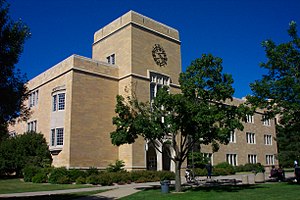
In 2005, a new apartment-style residence hall was built on an existing parking lot.[12] McNeely Hall was also built the following year. It is a large classroom building for business that replaced the smaller building of the same name.[13] A new residential village, more parking ramps, and general planning all have been negotiated successfully with the surrounding neighborhood. These developments are expected to begin within the next five years.[citation needed]
In early 2012, St. Thomas completed the final stage of its three-building expansion on the St. Paul campus.[14] The two main additions that were completed are the Anderson Athletic and Recreation Center (AARC) and the Anderson Student Center. These projects were completed in the summer of 2010 and January 2012, respectively.[15] The Anderson Athletic and Recreation Center has a field house, basketball arena, weight room, and swimming pool.[16] The track in the field house is home to the most dominant track team in the MIAC conference. Other St. Thomas sports that use the AARC's facilities have also had recent success, including a playoff run for the football team, and a national championship for the men's basketball team.[citation needed] The new Anderson Student Center is home to new food venues, as well as entertainment options, including a game room and bowling alley, and a coffee shop. An art gallery on the second floor is home to the American Museum of Asmat Art.[17]
Minneapolis[]
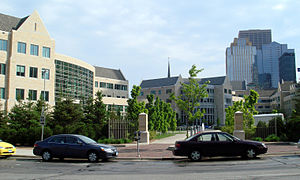
In fall 1992, the university opened a permanent 150,000 sq ft (14,000 m2) campus at 1000 LaSalle Ave. in Minneapolis. The first building, named Terrence Murphy Hall in May 2000, is headquarters to the university's Opus College of Business. Artist Mark Balma created one of the largest frescoes in the United States on the arched ceiling of its atrium.[18] The seven-panel, 1,904 square feet (176.9 m2) fresco was completed in the summer of 1994 and portrays the seven virtues discussed in the writings of St. Thomas Aquinas. The Minneapolis campus also holds St. Thomas' School of Education, the School of Law, and Schulze School of Entrepreneurship.
Daniel C. Gainey Conference Center (Owatonna)[]
As announced on May 15, 2014, the Daniel C. Gainey Conference Center was to be sold to Meridian Behavioral Health, LLC, with a plan to convert it to a treatment facility for addiction and behavioral disorders. The deal closed in August 2014. The deal included the entire 180-acre property and all the buildings except for the Winston Guest House, which was designed by architect Frank Gehry. St. Thomas is still exploring options for the house, which was to remain on the Gainey property for up to two years.[19] Terms were not disclosed.[20]
Bernardi (Rome)[]
Since 1999, the University of St. Thomas has been the only university in the United States to have a formal affiliation with the Pontifical University of St. Thomas Aquinas (Angelicum).[21]
Academics[]
Each year, the university awards almost 2,500 degrees, including five different bachelor's degrees (B.A., B.M., B.S., B.S.M.E. and B.S.E.E.). It has 88 major fields at the undergraduate level, with 59 minor fields of study and seven preprofessional programs. At the graduate and professional level, the university offers 41 master's degrees, two education specialist degree, one juris doctor, and five doctorates.
Schools and colleges[]
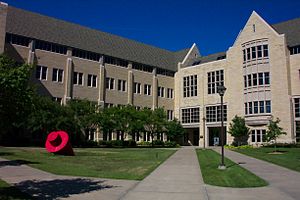
The university offers its degree programs through nine divisions. The College of Arts and Sciences includes undergraduate departments in the arts, humanities, natural sciences, and social sciences, plus a number of interdisciplinary programs. The Opus College of Business has seven departments offering graduate and undergraduate curricula including Executive Education and Professional Development at University of St. Thomas, and is one of six AACSB accredited business schools in Minnesota.[22] St. Thomas also houses the Saint Paul Seminary School of Divinity, which offers master's- and doctoral-level degrees oriented to theological study and the practice of ministry. St. John Vianney Seminary, a minor college seminary, is also at St. Thomas. Other schools include the School of Education, the School of Engineering, and the School of Social Work. The Master of Social Work is offered as a double degree program with the St. Catherine University.
Schools housed on the Minneapolis campus include the Graduate School of Professional Psychology, Undergraduate and Graduate Schools of Education, Graduate Programs in Software Engineering, and the School of Law, which was re-opened in 1999 after a 66-year hiatus.
The University of St. Thomas is a member of the Associated Colleges of the Twin Cities (ACTC), a consortium of five private liberal arts colleges. This program allows students to take classes at one of the associated colleges for no additional cost. Other schools include Hamline University, St. Catherine University, Macalester College, and Augsburg University.[23]
In 2017, St. Thomas was named a Changemaker Campus by joining AshokaU, a higher education consortium that focuses on social innovation in higher education.[24]
Athletics[]
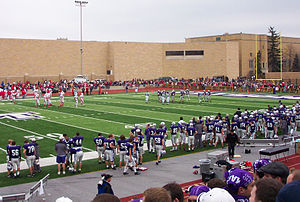
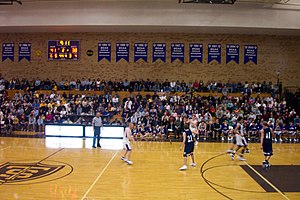
St. Thomas's school colors are purple and gray, and the athletic teams are called the Tommies. The mascot for these teams is "Tommie". "Tommy" was changed to the "ie" spelling when women were accepted as full-time students, to be more inclusive.
St. Thomas were a member of the Minnesota Intercollegiate Athletic Conference (MIAC), which performs at the NCAA Division III level. Since 1885, athletics have been present on St. Thomas' campus. The first sports teams that became popular were intramural. The top intramural baseball teams in the 1890s were the "Blues" and "Grays", which is where the school colors come from. Varsity sports did not begin until 1904. St. Thomas celebrated its 100th year of varsity athletics in 2003–2004.[25]
St. Thomas' longtime archrival is Saint John's University from Collegeville, Minnesota. Recent national titles include men's basketball in 2011 and 2016;[26] men's baseball in 2009 and 2001; women's softball in 2005 and 2004; men's lacrosse (MCLA Division II) in 2019, 2016, 2013, 2012, 2010 and 2009; women's volleyball in 2012; and dance team in 2017, 2016, 2015, 2014, 2013, 2012, 2011, 2010, 2008 and 2006. St. Thomas also won national championships with women's basketball in 1991; men's cross country in 1986 and 1984; men's indoor track in 1985; and women's cross country in 1987, 1986, 1984 and 1982. In 2012, St. Thomas played for the first time in the Stagg Bowl in Salem, Virginia, which is the Division III Football National Championship game, against the University of Mount Union, losing 28-10.[27] In 2015, St. Thomas reached the Stagg Bowl for the second time, prompting another championship match against Mount Union. St. Thomas ultimately ended up losing the game, with a final score of 49-35.[28]
WCCO has broadcast radio coverage of Tommies football games since 2011.[29]
On May 22, 2019 it was announced that St. Thomas was "involuntarily removed" from the MIAC.[30] St. Thomas was to have been allowed to remain as a member of the conference until the spring of 2021 while they searched for a new conference had that become necessary but would be allowed to leave at an earlier date should a new conference accept them prior to spring 2021 or should they have decided to become an independent. On October 4, 2019, St. Thomas announced that it had been invited to the Summit League, an NCAA Division I conference. This announcement also noted that St. Thomas had applied for a waiver from the NCAA to move directly from Division III to Division I beginning with the 2021-22 season. While the process of transitioning from Division III to Division I normally takes twelve years and requires transitioning through Division II, on July 15, 2020, the NCAA announced they had approved St. Thomas's application to move directly to Division I. As the Summit League does not sponsor football or ice hockey, St. Thomas joined the Pioneer Football League for football, the CCHA for men's hockey[31] and the WCHA for women's hockey. [32][33]
Student life[]
Student housing[]
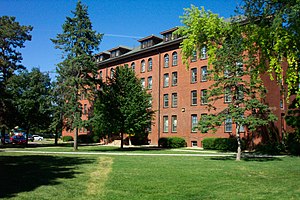
Undergraduate housing is found on the St. Paul Campus. Approximately 2,400 residents live in 10 traditional halls and apartments. Additionally, St. John Vianney College Seminary holds approximately 140 students. All but one (Murrary Herrick) traditional halls are single-sex, while apartment residences are co-ed by floor. Residence halls on campus are named after Archbishops of St. Paul-Minneapolis, such as William O. Brady, Austin Dowling, and John Ireland. The all-female traditional hall of John Paul II is named after the former Pope. Built in 1894, Cretin Hall is the oldest hall on campus and was designed (along with Loras and Grace halls) by Emmanuel Louis Masqueray.
Recently the department of residence life has purchased additional buildings on what they are calling 'mid-campus' in the area between Grand and Summit Avenues. These buildings house men and women transfer students in one of two buildings, separated by gender. There are two apartment complexes that are specifically designed for sophomores. Students are also housed in the residence above the Child Development Center, a day-care facility on campus.
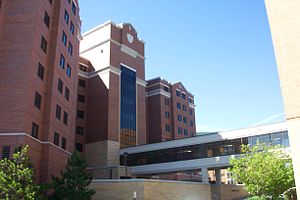
The University of St. Thomas offers special interest floors, or floors that are intended to house specific residents with similar interests or class standing. Almost one-third of all floors are First Year Experience floors, which consist of only freshmen. This practice attempts to create a cohesive community by placing students together who will have a similar experience. First year students have the opportunity to participate in Living Learning Communities (LLCs). These include Sustainability, Aquinas Scholars, Tommies Do Well(ness), Pathways to Engineering, COJO MOJO, Bridging Divides, Catholic Studies, Major Explorers, and Business for the Common Good.[34]
Housing policies
The campus is not dry: students over 21 years of age are allowed alcohol in their rooms.
Undergraduate Student Government[]
The on-campus student association is the Undergraduate Student Government (USG), formerly known as the ACC. The student government is made up of an executive board and general council. Each executive board member receives a stipend. The executive board consists of the president of the student body, executive vice president, vice president of financial affairs, vice president of academic affairs, vice president of administrative affairs and vice president of public relations. The general council consists of class presidents, class senators and representatives from various university organizations.
The student government oversees funding to all clubs on campus, approves new club requests, appoints students to various university committees and represents the student body to the administration. USG has its own offices located in the student center. Elections are held in the fall and spring every academic year.
Controversy[]
Desmond Tutu[]
In 2007, the president of the University of St. Thomas, Father Dennis Dease, cancelled a planned speech by Nobel Peace Prize laureate and anti-apartheid figure, Desmond Tutu, on the grounds that his presence might offend some members of the local Jewish community.[35] Many faculty members of led an email campaign calling on St. Thomas to reconsider its decision,[36] which the president did and invited Tutu to campus.[37] Tutu declined the re-invitation, speaking instead at the Minneapolis Convention Center at an event hosted by Metropolitan State University.[38] However, he addressed the issue two days later while making his final appearance at Metro State.
Demolition of Foley Theater[]
In 2008, plans were announced to the public that the theater department at the University of St. Thomas was to be dissolved and that the school would no longer offer this major. Declining numbers of theater majors was publicly cited as the reason. However, during this same time, plans were underway to make space for a new student center to be named after the Anderson family, then the largest single donors to a single private institution in United States history. Despite protests from senior faculty and students, the decision was made to demolish the theater and dissolve the department the same semester; though, according to the Dean of St. Thomas's College of Arts and Sciences, Marisa Kelly, the two decisions were "completely unrelated".[39]
Notable faculty and staff[]
- John Abraham – professor in the School of Engineering
- Michael Murphy Andregg – geneticist and peace activist
- Archbishop William Brady
- Don J. Briel – Professor of Catholic Studies
- Glenn Caruso – head football coach
- Bishop Andrew H. Cozzens – Professor of Divinity
- Robert Delahunty – internationally recognized professor of law
- David Durenberger – U.S. Senator from Minnesota
- Massimo Faggioli – theology professor
- Father Michael Joncas - professor of Catholic Studies
- Ellen J. Kennedy – genocide scholar
- John Jeremiah Lawler – Professor of Divinity
- Nekima Levy-Pounds – President of the Minneapolis NAACP
- Whitney MacMillan – former Chairman of the Board and Chief Executive Officer of Cargill
- Eugene McCarthy – U.S. Senator and Representative
- Eoin McKiernan – early scholar in Irish Studies
- Harry Mehre – football and basketball coach
- Thomas Mengler – Dean of the School of Law
- Larry Miggins – baseball coach
- Leslie Adrienne Miller – poet
- Charles Morerod – Director of the Rome Program in Catholic Studies
- Rachel Paulose – Visiting Professor of Law
- Mary Rose O'Reilley – poet
- Mark Osler – Professor of Law
- Bishop Lee A. Piché – theology
- David Renz – Professor of Public Policy
- John A. Ryan – moral theologian
- Patrick J. Schiltz – U.S. federal judge
- Katarina Schuth – Professor for the Social Scientific Study of Religion
- Janet E. Smith – moral theologian
- David Strom – Professor of Political Philosophy
- Peter Vaill – Professor of Management
- Robert Vischer – Dean of the School of Law
Notable alumni[]
Academia and education[]
- Tim Callahan – geologist
- Dennis Dease – former President of the University of St. Thomas
- Richard DeMillo – computer scientist
- Mark Dienhart – educator
- Tom Dooher – president of Education Minnesota
- Abraham Kaplan – philosopher
- Rick Krueger – educator
- Stephen A. McCarthy – director of the Cornell University libraries
- John A. Ryan – theologian
- Edward J. Walsh – journalist
Arts and entertainment[]
- Felix Biederman – writer, gamer, co-host of Chapo Trap House
- Larry Bond – game designer and author
- Dottie Cannon – Miss Minnesota USA 2006
- Vince Flynn – author
- T. R. Knight – actor
- Glenn Lindgren – TV chef and food writer
- Thomas Melchior – author
- T.D. Mischke – radio talk show host
- Evan Schwartz – author
- Ali Selim – film director
- Joe Soucheray – radio talk show host
- John Vachon – photographer
Athletics[]
- Adrian Baril – professional football player
- Brady Beeson – professional football player
- Jim Brandt – professional football player
- Herb Franta – professional football player
- Courtney George – professional curler
- Tommy Gibbons – Hall of Fame boxer, sheriff of Ramsey County, Minnesota 1934–1959
- Neal Guggemos – professional football player
- Red Hardy – professional baseball player
- Walt Kiesling – professional football player and coach, member of the Pro Football Hall of Fame
- John Kundla – first coach for the Minneapolis Lakers
- Horace LaBissoniere – professional football player
- Jake Mauer – professional baseball player and coach
- Chuck Reichow – professional football player
- Isaac Rosefelt – American-Israeli basketball player
- Don Simensen – football player
- Larry Steinbach – football player
- Roy Vassau – professional football player
- Joe Warren – professional soccer player
Business and leadership[]
- Ben Anderson – entrepreneur
- Robert Buss – managing director, Disciplined Growth Investors
- Jack Casey – business professional
- – Chief Executive Officer of U.S. Bancorp[40]
- Ron Fowler – owner, San Diego Padres
- John Schneider – general manager of the Seattle Seahawks
- Bob Short – businessman, sport teams owner and politician
- Ann Winblad – venture capitalist
Law, politics, government, and military[]
- Semhar Araia – social activist
- James N. Azim, Jr. – Wisconsin State Assemblyman
- Mike Beard – member, Minnesota House of Representatives
- William V. Belanger, Jr. – Minnesota State Senator
- Michelle Benson – Minnesota State Senator
- David H. Bieter – mayor of Boise, Idaho
- John E. Boland – member, Minnesota House of Representatives
- Stephen F. Burkard – attorney
- Michael Ciresi – attorney
- Ted Daley – Minnesota State Senator
- Gary DeCramer – Minnesota State Senator
- Terry Dempsey – member, Minnesota House of Representatives
- Joe Dunn – California State Senator
- Sondra Erickson – member, Minnesota House of Representatives
- Peter Fischer – member, Minnesota House of Representatives
- Burke Harr – Nebraska State Senator
- John Harrington – chief of metro transit police in Minneapolis/St. Paul
- Brian H. Hook – former Assistant Secretary of State for International Organization Affairs
- Paul Kohls – member, Minnesota House of Representatives
- Charles B. Kornmann – United States federal judge
- Arthur Lenroot, Jr. – Wisconsin State Senator
- Patrick Lucey – Governor of Wisconsin
- Erin Maye Quade – member, Minnesota House of Representatives
- Mike McFadden – 2014 Republican candidate for U.S. Senate from Minnesota
- Jim Oberstar – former U.S. Congressman
- James Hugh O'Neill – brigadier general, U.S. Army
- Cindy Pugh – member, Minnesota House of Representatives
- Patrick J. Ryan – chief of chaplains of the U.S. Army
- Henry Timothy ("Tim") Vakoc – first U.S. military chaplain to die from wounds received in the Iraq War
- Conrado Vega – Minnesota State Senator
- D.D. Wozniak – former chief judge of the Minnesota Court of Appeals
Religion[]
- Bishop Joseph John Annabring
- William Henry Bullock
- James Joseph Byrne – Archdiocese of Dubuque
- Bishop Frederick F. Campbell
- Archbishop. Robert J. Carlson – Archdiocese of St. Louis
- Bishop Peter F. Christensen
- Bishop Leonard Philip Cowley
- Archbishop Blase J. Cardinal Cupich – Archdiocese of Chicago
- John Francis Doerfler
- Paul Vincent Dudley
- Archbishop Paul D. Etienne
- Lawrence Alexander Glenn
- David Haas
- Hilary Baumann Hacker
- Lambert Anthony Hoch
- Edward Howard
- James Keane
- Francis Martin Kelly
- Bishop Arthur Kennedy
- Bishop John Francis Kinney
- Louis Benedict Kucera
- Raymond W. Lessard
- Bishop John M. LeVoir
- Raymond Alphonse Lucker
- Bishop Lawrence James McNamara
- John Jeremiah McRaith
- William Theodore Mulloy
- Gerald Francis O'Keefe
- Bishop Richard Pates
- Bishop Lee A. Piché
- Archbishop John Roach – Archdiocese of St. Paul and Minneapolis
- Archbishop Alexander King Sample – Archdiocese of Portland
- Francis Joseph Schenk
- Alphonse James Schladweiler
- Archbishop Fulton J. Sheen – titular see of Newport, Wales
- George Henry Speltz
- Rose Thering – social activist
- Sylvester William Treinen
- Nicolas Eugene Walsh
- Thomas Anthony Welch
- Stephen S. Woznicki
Other[]
- Dan Buettner – explorer, educator, author
- Daerek "LemonNation" Hart – professional League of Legends player
- Hussein Samatar – politician, banker, and community organizer
- Will Steger – polar explorer
See also[]
- List of colleges and universities in Minnesota
- Higher education in Minnesota
References[]
- ^ Jump up to: a b "Quick Facts". About University of St. Thomas. University of St. Thomas. Retrieved December 16, 2017.
- ^ As of June 30, 2019. "U.S. and Canadian 2019 NTSE Participating Institutions Listed by Fiscal Year 2019 Endowment Market Value, and Percentage Change in Market Value from FY18 to FY19 (Revised)". National Association of College and University Business Officers and TIAA. Retrieved July 11, 2020.
- ^ Kennedy, Patrick. "Minnesota Nonprofit 100". StarTribune News. Minneapolis StarTribune. Retrieved December 16, 2017.
- ^ Jump up to: a b c Stojsavljevic, Brittany. "Freshman Class Maintains Record-setting Academic Profile, Is Most Diverse". University of St. Thomas Newsroom. University of St. Thomas. Retrieved December 16, 2017.
- ^ "America's Top Colleges 2019". Forbes. Retrieved August 15, 2019.
- ^ "Wall Street Journal/Times Higher Education College Rankings 2021". The Wall Street Journal/Times Higher Education. Retrieved October 20, 2020.
- ^ "2021 Best National University Rankings". U.S. News & World Report. Retrieved September 24, 2020.
- ^ "2020 National University Rankings". Washington Monthly. Retrieved August 31, 2020.
- ^ Jump up to: a b Jarchow 1973, pp. 39–40.
- ^ Murphy 2001, pp. 7.
- ^ "Summit Avenue". Project for Public Spaces. Archived from the original on September 30, 2012. Retrieved December 12, 2012.
- ^ "Take a look at new Selby Hall today, Sept. 6" (Press release). University of St. Thomas. September 6, 2005. Archived from the original on February 1, 2014. Retrieved December 12, 2012.
- ^ "McNeely Legacy Opens Doors" (Press release). University of St. Thomas. November 15, 2006. Archived from the original on February 1, 2014. Retrieved December 12, 2012.
- ^ "Construction Projects". University of St. Thomas. Retrieved December 12, 2012.
- ^ Kimball, Joe (October 18, 2012). "University of St. Thomas raises more than $500 million in capital campaign". Minn Post. Retrieved December 12, 2012.
- ^ "Anderson Athletic and Recreation Complex". University of St. Thomas. Retrieved December 12, 2012.
- ^ Jossi, Frank (January 19, 2012). "Building Blocks – University of St. Thomas' Anderson Student Center". Finance and Commerce. Minneapolis: Dolan Media. Retrieved May 1, 2017.
- ^ Fedo, Michael (November 19, 1993). "Artist Mark Balma's Lasting Impression". The Christian Science Monitor: 12. ISSN 0882-7729. Retrieved December 11, 2012.
- ^ http://www.southernminn.com/owatonna_peoples_press/article_84ed2764-6c61-5be4-a30c-1f1da8aa231a.html Deadline set on Winton House move: University has two years after sale of Gainey Center September 30, 2014 Retrieved October 23, 2014
- ^ http://www.bizjournals.com/twincities/news/2014/05/15/university-of-st-thomas-owatonna-conference-center.html?page=all University of St. Thomas finds buyer for Owatonna conference center May 15, 2014 Retrieved October 23, 2014
- ^ Pontifical University of Saint Thomas Aquinas, Angelicum, Handbook of Studies 2012- 2013, p. 303 http://www.pust.it/ Archived March 14, 2018, at the Wayback Machine
- ^ "St. Thomas' Opus College of Business receives AACSB accreditation : Opus College of Business : University of St. Thomas". Stthomas.edu. Retrieved October 2, 2011.
- ^ Murphy 2001, pp. 8, 33.
- ^ Osterman '11, Jordan (April 4, 2017). "St. Thomas Is First in Minnesota Named Changemaker Campus".
- ^ "Traditions & Spirit". University of St. Thomas Athletics. Archived from the original on December 27, 2007. Retrieved January 27, 2008.
- ^ "St. Thomas pounds Wooster for D-III men's title". ESPN.com. March 19, 2011. Retrieved March 19, 2018.
- ^ "St. Thomas reaches Div. III title game". ESPN. December 6, 2012. Retrieved December 9, 2012.
- ^ Berkes, Peter (December 18, 2015). "Mount Union beats St. Thomas for 12th D3 title". SBNation.com.
- ^ "WCCO Radio to broadcast St. Thomas football games". WCCO.com. WCCO. Retrieved May 11, 2011.
- ^ Medcalf, Myron (May 22, 2019). "St. Thomas wins too much, kicked out of MIAC". ESPN.com. ESPN. Retrieved October 4, 2019.
- ^ "CCHA Welcomes The University Of St. Thomas". Northern Michigan University. July 29, 2020. Retrieved July 29, 2020.
- ^ Scoggins and Christensen, Chip and Joe. "St. Thomas announces intentions to go Division I after getting removed from MIAC". Star Tribune. Star Tribune. Retrieved October 4, 2019.
- ^ Ryan, Megan. "St. Thomas gets approval from NCAA to go Division I". Star Tribune. Retrieved July 15, 2020.
- ^ "LLCs – Residence Life – University of St. Thomas – Minnesota". www.stthomas.edu. Retrieved March 19, 2018.
- ^ Furst, Randy (October 4, 2007). "St. Thomas won't host Tutu". Minneapolis Star Tribune.[permanent dead link]
- ^ Furst, Randy (October 15, 2007). "St. Thomas urged to reconsider its decision not to invite Tutu". Minneapolis Star Tribune. Archived from the original on March 23, 2009. Retrieved October 7, 2007.
- ^ "UST president says he made wrong decision, invites Tutu to campus". University of St. Thomas Bulletin. Archived from the original on October 13, 2007. Retrieved October 7, 2007.
- ^ Mador, Jessica (April 12, 2008). "Desmond Tutu avoids politics while talking about peace". Minnesota Public Radio. Retrieved May 6, 2008.
- ^ Furst, Randy (October 9, 2008). "St. Thomas drops the curtain: Eliminates theater department, slates Foley Theater for destruction". Twin Cities Daily Planet. Retrieved February 24, 2014.
- ^ "Andrew J. Cecere, 58, Chairman, President & Chief Executive Officer, U.S. Bancorp".
Bibliography[]
- Jarchow, Merrill E. (1973). Private liberal arts colleges in Minnesota: their history and contributions. St. Paul: Minnesota Historical Society. ISBN 9780873510813.
- Murphy, Terrence J. (2001). A Catholic university: vision and opportunities. Collegeville: The Order of St. Benedict. ISBN 9780814651018.
External links[]
| Wikimedia Commons has media related to University of St. Thomas (Minnesota). |
- University of St. Thomas (Minnesota)
- Educational institutions established in 1885
- Association of Catholic Colleges and Universities
- Universities and colleges in Minneapolis
- Universities and colleges in Saint Paul, Minnesota
- 1885 establishments in Minnesota
- Catholic universities and colleges in Minnesota
- Liberal arts colleges in Minnesota


